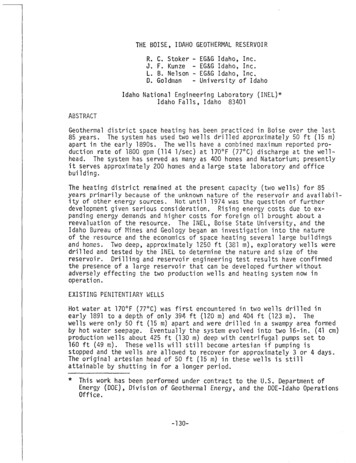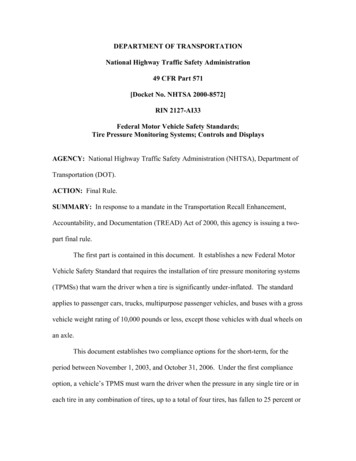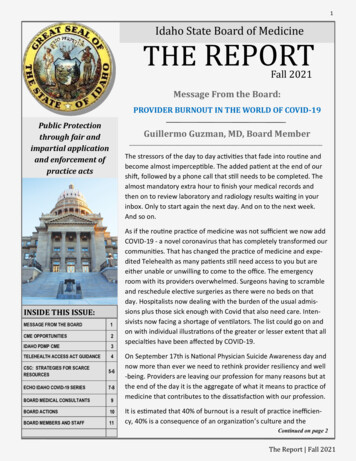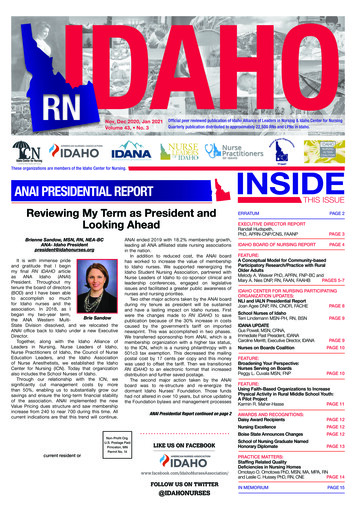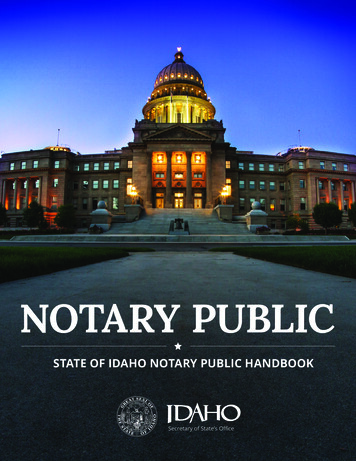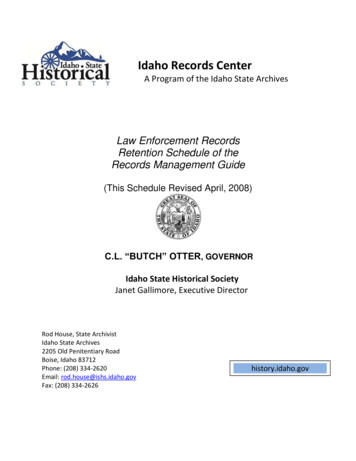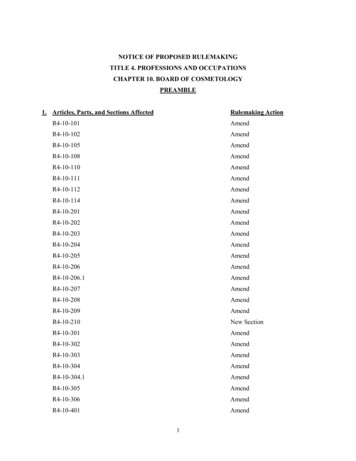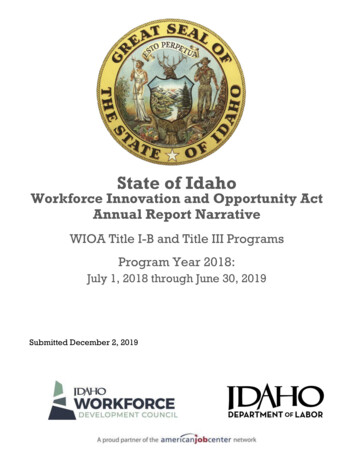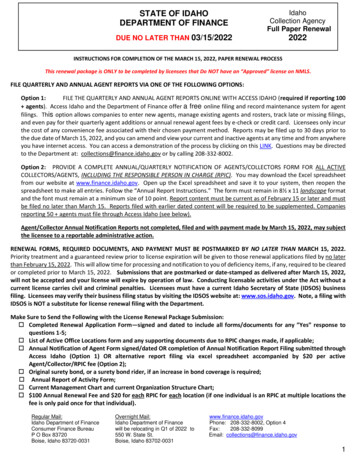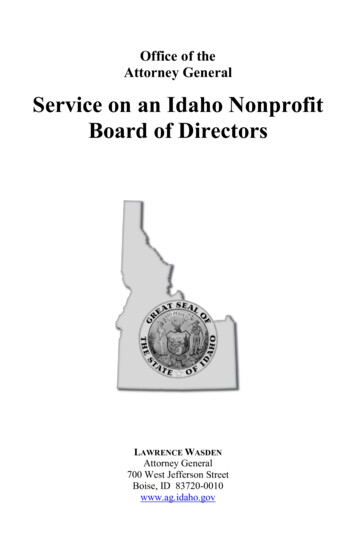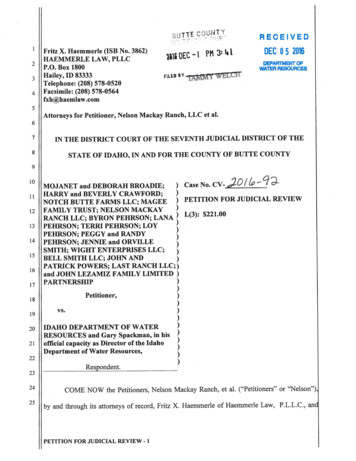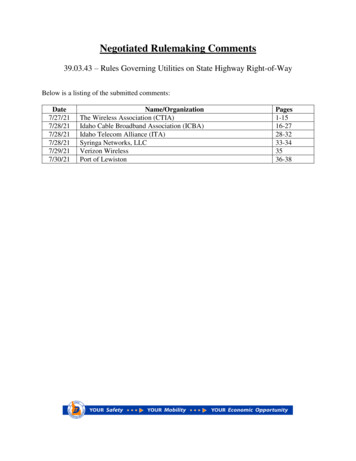
Transcription
Negotiated Rulemaking Comments39.03.43 – Rules Governing Utilities on State Highway Right-of-WayBelow is a listing of the submitted 30/21Name/OrganizationThe Wireless Association (CTIA)Idaho Cable Broadband Association (ICBA)Idaho Telecom Alliance (ITA)Syringa Networks, LLCVerizon WirelessPort of LewistonPages1-1516-2728-3233-343536-38
BEFORE THE IDAHO TRANSPORTATION DEPARTMENTRules Governing Utilities on State HighwayRight-of-Way))Docket No. 39-0343-2102COMMENTS OF CTIAI.INTRODUCTION AND SUMMARYCTIA – The Wireless Association1 appreciates the opportunity to submit these commentson the Idaho Transportation Department’s (“Department’s”) Notice of Intent to PromulgateRules to update its Guide for Utility Management (“GUM”), which governs utility facilities onhighway rights-of-way (“ROW”).2 CTIA commends the Department for its collaborativenegotiated rulemaking process, including holding several constructive workshops, and providesthese comments in that same constructive spirit.When it began this proceeding, the Department stated that it sought to promote the use ofrights-of-way to support broadband networks: “As the Idaho Transportation Departmentcontinues its efforts to address utility accommodation of broadband facilities seeking access tothe state’s ROW, ITD is initiating this negotiated rulemaking process to further analyze andCTIA – The Wireless Association (“CTIA”) (www.ctia.org) represents the U.S. wireless communicationsindustry and the companies throughout the mobile ecosystem that enable Americans to lead a 21st centuryconnected life. The association’s members include wireless carriers, device manufacturers and suppliers, as well asapps and content companies. CTIA vigorously advocates at all levels of government for policies that fostercontinued wireless innovation and investment. The association also coordinates the industry’s voluntary bestpractices, hosts educational events that promote the wireless industry and co-produces the industry’s leadingwireless tradeshow. CTIA was founded in 1984 and is based in Washington.12Idaho Transportation Department, Rules Governing Utilities on State Highway Right-of-Way, Docket No. 390343-2012, Notice of Intent to Promulgate Rules, Idaho Administrative Bulletin (June 2, 2021) (“Notice”).11
update the necessary policies and procedures, while also meeting federal requirements andsupporting Governor Little’s initiative to improve broadband access in Idaho.” 3The Department’s rulemaking comes at a critical time for broadband deployment. Idahoin particular has made rapid broadband deployment a statewide policy objective, and both federaland state policymakers have acknowledged the enormous economic and social benefits thatbroadband can deliver, and are committing funding to pay for broadband deployment to close thedigital divide.The Department has the opportunity in this rulemaking to promote the public’s access towireless broadband services, including fifth-generation (“5G”) services, by streamlining itsprocedures for approving wireless facilities along state roads and highways. Those locations areoften optimal for wireless networks because of their proximity to large volumes of wirelesstraffic. Installing antennas and supporting facilities along rights-of-way will deliver advancedwireless services, including broadband service, to the public in rural as well as urban areas,benefiting consumers, public safety agencies, and other users across the state. Adoptingreasonable cost-based siting fees, simple permit application procedures, and timelines for actingon applications will incent wireless providers to invest in new infrastructure in Idaho, directlybenefiting the public and the state’s economy. Moreover, those fees, procedures, and deadlinescan be adopted consistent with the Department’s mission to oversee a comprehensive and safestate highway system.The wireless industry looks forward to collaborating with the Department to develop andimplement rules that will incent deployment of state-of-the-art communications networks along3Notice at 65.22
state roads and highways. In particular, CTIA supports the Department’s proposal to adopt a feeschedule for wireless broadband facilities that is consistent with the Federal CommunicationsCommission’s (“FCC’s”) landmark 2018 Declaratory Ruling interpreting the CommunicationsAct. The FCC determined that this federal law requires states and localities to adopt cost-basedfees for small wireless facilities and to ensure that fees for larger facilities are reasonable and donot have the effect of inhibiting deployment. Recent written guidance from the Federal HighwayAdministration (“FHWA”) allows state transportation departments to adopt cost-based fees thatalign with the FCC’s 2018 Declaratory Ruling by determining either that providers are “utilities”under state law, or that deployment of new or upgraded facilities serves the public interest. TheDepartment can with confidence make both of these determinations as to wireless facilities.Establishing cost-based fees for wireless facilities will directly promote Idaho’s policy to expandbroadband access, because they will encourage investment in new and upgraded facilities acrossthe state.CTIA also recommends that the Department make a small number of targeted revisionsto its proposed update of the GUM in order to streamline permitting procedures and thusaccelerate broadband deployment along Idaho’s highways. The Department should, among otherrevisions, make clear that its procedures apply to larger as well as smaller wireless facilities andto modifications to existing facilities, adopt a forward-looking definition for next-generationtechnologies, implement specific time periods for acting on permit applications, include thecompletion of negotiated Master Lease Agreements within those periods, and limit the aestheticcontrol provisions to environmentally or historically sensitive locations. These revisions, furtherdiscussed below, will help to achieve Idaho’s policy objective to make broadband serviceavailable statewide.33
II. ACCELERATING BROADBAND DEPLOYMENT ALONG HIGHWAY ROWWILL HELP FULFILL A CARDINAL IDAHO AND FEDERAL POLICYOBJECTIVE.In October 2019, the Idaho Broadband Task Force issued its report recommendingactions to improve broadband speed, connectivity and infrastructure across Idaho. The TaskForce concluded: “Like water, electricity and highways, Idaho citizens, communities andbusinesses, in both urban and rural areas, must have access to secure, reliable, affordablebroadband internet speeds in order to grow, thrive and connect to the world. . . . Access tobroadband and high-speed internet services is an urgent priority for Idahoans in all corners of thestate.”4Expanding access to broadband is a critical state and national priority. Congress, theBiden Administration, and the FCC have all recognized that broadband will deliver enormousbenefits to consumers, businesses, and the economy. For example, a CTIA study completed inFebruary 2021 calculated that 5G (which delivers broadband as well as voice and other wirelessservices) will contribute roughly 1.5 trillion to U.S. GDP, and create approximately 4.5 millionadditional jobs over the next decade.5The FHWA also supports highway ROW use policies that expand the availability ofbroadband services. On April 22, 2021, it issued a national Guidance Document (discussedfurther below) in which it “supports the consistent utilization of the ROW” for projects that servethe public interest.6 FHWA specifically identifies broadband as one such type of project, andIdaho Broadband Task Force, “Broadband Access is Imperative for Idaho: Recommendations to Improve Idaho’sBroadband Plan” (Oct. 31, 2019) at 3.4See CTIA, “Building the 5G Economy: The Wireless Industry’s Plan to Invest and Innovate in the U.S.” (February2021), available at 21-Wireless-Briefing-2 9.pdf (last accessedJuly 28, 2021).56Memorandum from Stacey Pollack, Acting Administrator, FHWA, to Directors of Field Services, DivisionAdministrators and Division Directors, “State DOTs Leveraging Alternative Uses of the Highway Right-of-WayGuidance” (April 22, 2021) (“Guidance Document”).44
directs its offices across the nation to “encourage State DOTs to consider practices that canfurther broadband deployment initiatives.”7The Department’s rulemaking is vital to achieving the national and State priority todeploy broadband and the Task Force’s vision for a robust, statewide broadband network.Idaho’s roads and highways are ideal locations for wireless broadband infrastructure. Idahoanscontinually travel on them, and they cross through every town, city and county, across the mostrural areas as well as more populated parts of the state. The COVID-19 epidemic hasdemonstrated the tremendous value of wireless technologies in keeping consumers, businesses,schools, and government support services interconnected. 8 Similarly, antennas along highwaysprovide improved wireless services for public safety agencies that perform their missions there,and will facilitate advanced services offered over wireless networks, such as autonomousvehicles.Given these consistent state and national policies to accelerate and expand the public’saccess to broadband and other advanced wireless services, the Department should adoptrevisions to the GUM that drive rapid expansion of these services to rural as well as urban areas.Accommodating wireless broadband facilities along highway ROW and adopting streamlinedpermitting procedures, including timelines for granting siting applications, can achieve thatobjective by facilitating ubiquitous deployment across Idaho.7Id. at 2.For specific examples and up-to-date news on the wireless industry’s COVID-19 relief efforts, see CTIA, “TheWireless Industry Responds to COVID-19”, available at https://www.ctia.org/covid-19 (last accessed July 28,2021).855
III.THE DEPARTMENT SHOULD ADOPT REASONABLE, COST-BASED FEESFOR WIRELESS BROADBAND FACILITIES.A.The Department Should Adopt Its Proposal to Set Fees in AccordanceWith the FCC’s Declaratory Ruling.The Department has appropriately recognized that setting reasonable, cost-based fees thatenable the Department to recover the costs it incurs to oversee that deployment is the correctframework for overseeing the installation of broadband facilities along state roads and highways.The deployment of antennas and support structures is extremely expensive, typically requiringthe expenditure of tens of thousands of dollars for a single site. Additional governmental fees,especially if those fees are assessed annually, will often undermine the financial case fordeployment, particularly in rural areas where expanded service is particularly needed.The Department proposes to adopt new Rule 620.02 governing the use of highway ROWfor “broadband wireless telecommunications.” 9 The rule states that “ITD will receive fair andreasonable compensation for access to Right-of-Way and attachment to ITD facilities inaccordance with Federal Communications Commission (FCC Declaratory Ruling 18-133).”10CTIA supports this rule because it is consistent with federal law and fulfills the policy objectiveof accelerating the public’s access to broadband services by reasonably constraining siting feesto a level that simultaneously allows the Department to recover its costs and encourages9GUM at 600-4. (Page references are to the proposed revision to the GUM, which the Department issued inconnection with announcing its Notice of Intent to Promulgate Rules.)10GUM at 600-5. See Accelerating Wireless Broadband Deployment by Removing Barriers to InfrastructureInvestment, Declaratory Ruling, 33 FCC Rcd 9088 (2018). In August 2020 the United States Court of Appeals forthe Ninth Circuit upheld the FCC’s interpretation of these statutory provisions and its requirement that fees for smallwireless facilities be cost-based: “As the FCC explained here, its cost-based standard would prevent excessive feesand effective prohibition of 5G services in many areas across the country.” City of Portland v. United States, 969F.3d 1020 (9th Cir. 2020). The Supreme Court denied a petition for certiorari of the Ninth Circuit’s decision on June28, 2021.66
broadband deployment. Rule 620.02 appropriately references and applies the FCC’s decision,and will encourage broadband deployment in Idaho.B.The Department’s Proposal to Adopt Fees Pursuant to the FCC’sDeclaratory Ruling Is Consistent with FHWA Regulations.Rule 620.02’s approach to broadband siting fees is also consistent with FHWAregulations governing the installation of broadband infrastructure along federally-fundedhighways and the FHWA’s April 2021 Guidance Document. The FHWA’s regulations arecodified in 23 CFR Parts 645 and 710. Although 23 CFR § 710.403(e) generally directs stateDOTs to recover the fair market value of the portion of the ROW that accommodates such uses,two exceptions apply to broadband facilities: ROW uses by utilities and uses that are in thepublic interest. The FHWA clarified in its Guidance Document that because wireless broadbandfacilities meet each of 23 CFR § 710.403(e)’s exceptions, the fair market value requirement forROW use does not apply.Utility Exception. 23 CFR § 701.403(e)(2) exempts “use by public utilities inaccordance with 23 CFR Part 645” from the fair market value requirement. FHWA’s regulationsstate that “in determining whether a proposed installation is a utility or not, the most importantconsideration is how the [State Transportation Department] views it under its own State lawsand/or regulations.”11 Under Title 40 of the Idaho Code, which governs highway regulation,wireless carriers meet the definition of “utility” applicable for the purposes of access to ROWs.Idaho Code § 40-210(4) defines a “utility” using much of the same broad language as FHWA’srules: ““Utility” means an entity comprised of any person, private company, public agency orcooperative owning and/or operating utility facilities”; ““Utility facility" means all privately,11See 23 C.F.R. § 645.209(m); see also Guidance Document at 3.77
publicly or cooperatively owned lines, facilities and systems for producing, transmitting ordistributing communications, cable television, electricity, light, heat, gas, oil, crude products,ore, water, steam, waste or storm water not connected with highway drainage and othersimilar commodities.” 12 The Legislature codified this definition of “utility” specifically foruse of the ROW by utilities, such as wireless providers, so it seems most appropriate for theDepartment to use this definition rather than the one arising under Title 61 of the Idaho Codethat presently is incorporated in the proposed revisions to the GUM. While CTIA suggeststhe Department use the Title 40 definition, wireless carriers meet the definition of utilityunder Title 61 as well. 13 Thus, under either approach, wireless carriers satisfy the exemption forutilities from FHWA’s fair market value requirement for ROW use.CTIA also notes that the Title 40 definition eliminates any need for the Department todistinguish in Section 615.00 between utilities that have obtained a certificate from the PublicUtilities Commission and those that have not, designating any that have not as “a non-publicutility.”14 CTIA is not aware that the term “non-public utility” arises anywhere under Idaho law.As the term does not appear to carry any significance regarding access to the ROW, there wouldbe no useful purpose served by separately defining utilities that have a Certificate ofConvenience and Necessity (“public utility”) and those that do not (“non-public utility”).Idaho Code § 40-210(4). Compare “Utility means a privately, publicly, or cooperatively owned line, facility orsystem for producing, transmitting, or distributing communications, cable television, power, electricity, light, heat,gas, oil, crude products, water, steam, waste, storm water not connected with highway drainage, or any other similarcommodity, including any fire or police signal system or street lighting system, which directly or indirectly servesthe public.” 23 CFR § 645.105.1213Title 61 defines public utilities to include telephone corporations, see Idaho Code § 61-129, and telephonecorporations include mobile providers like CTIA’s wireless members because they provide telecommunicationsservices as such services are defined at Idaho Code § 61-129. Although wireless providers are considered publicutilities under Title 61, they are exempted “from any requirement of title 61, or chapter 6, title 62, Idaho Code.”Idaho Code § 61-121(1).14GUM at 600-1.88
Maintaining such separate definitions, however, does burden the Department to have to ensurethat its references to utilities include each type, unnecessarily complicating matters for theDepartment.Public Interest Exception. In addition to the FHWA’s utility exception to the fair marketvalue requirement for highway ROW uses, a separate regulation provides that this requirementalso does not apply when “an exception is in the overall public interest based on social,environmental, or economic benefits.” 15 The FHWA’s April 22, 2021 Guidance Document citedabove explicitly concludes that installing broadband facilities along highway ROW meets thispublic interest exemption: “The FHWA has also determined that broadband installation canassist with equitable communications access. These non-highway alternative uses of highwayROW are in the public interest.”16 FHWA thus properly concludes that the deployment of newor upgraded wireless infrastructure along highway ROW serves the “overall public interest” byexpanding or enhancing the public’s access to broadband. The FHWA’s determination isconsistent with 23 CFR § 645.205, which states that it is in the public interest to accommodateutility facilities on the highway ROW of a Federal-aid or direct Federal highway project.Idaho’s legislature has found that important benefits to the public result from grantingutilities access to state highway ROW. It has declared to be its “legislative intent” that ROW are“lawfully used in connection with uses associated with utility purposes necessary to provideutility services to the public. Without making use of public highways and their associatedrights-of-way, the utility facilities and services could not reach or economically serve the1523 CFR § 710.403(e)(1).16Guidance Document at 4.99
residents of the state of Idaho.”17 The Department can and should add language to the GUMexpressly making the same determination.In sum, the Idaho Code and the FHWA’s Guidance Document provide the Departmentwith the clear legal bases to incorporate the national policies the FCC adopted for cost-basedwireless siting fees into the Department’s rules governing broadband facilities along highwayROW. It can conclude that broadband providers, like wireless carriers, satisfy the Idahodefinition of “public utility” 18 and shall be treated as such for the purpose of receiving anexception to the FHWA’s fair market value requirement. Or, it can find that the use of highwayROW to support broadband infrastructure serves the public interest. By applying either of theexclusions the FHWA provides, the Department can set reasonable, cost-based fees that are bothconsistent with FCC and FHWA regulations and that will advance Idaho’s policy to promotebroadband deployment.IV.THE DEPARTMENT SHOULD MAKE TARGETED REVISIONS TO CERTAINPROPOSED RULES TO STREAMLINE THE EXPANSION OF WIRELESSBROADBAND SERVICES.CTIA broadly supports the Department’s proposed rules because they properly recognizethe benefits that locating broadband facilities along highway ROW will deliver across Idaho.The Department can magnify those benefits by modifying a handful of its proposed rules toprovide more clarity and certainty to broadband providers and by streamlining its permittingprocesses.17Idaho Code § 40-210(1).18See Idaho Code § 40-210(4).1010
Section 110.00 – Definition of Small Wireless Facility.19 The definition of this term islargely consistent with the definition in the FCC’s rules. 20 However, item (6) in the definitionshould refer explicitly to the FCC’s rule governing radiofrequency radiation, 47 C.F.R. §1.1307(b) (as the FCC’s definition does) to more accurately identify the applicable standard.Section 110.00 – Definition of 5G.21 Wireless technologies are continually evolving.Only a few years ago fourth-generation services (“4G”) were state of the art. The Departmentshould make its definition forward-looking and refer to all future generations of technologies(5G included) by using the term “next generation” instead of 5G.In addition, the Department should clarify its rules to provide that the definition of nextgeneration wireless facilities includes both small facilities (as defined in Section 110.00, whichgenerally incorporates the FCC’s definition of that term) and wireless facilities that do not meetthe small cell definition. Wireless networks rely on both small and larger facilities depending onthe broadband coverage that is needed in a particular geographic area, the radio frequencies thatproviders have access to, and the characteristics of the terrain. Particularly along highways thattraverse rural areas or areas with rough terrain, larger facilities may be required to provide highservice quality and adequate coverage. The Department should not inadvertently discourageservice in these areas by imposing additional permitting burdens on those larger facilities.Section 620.01 – Broadband Fiber Optic Telecommunications.22 This proposed ruleappears to apply to wireline facilities only. However, its provisions addressing “SharedResource Agreements” and “Mutually Agreed Upon Exchanges of Facilities and Services” are19GUM at 100-3.20See 47 C.F.R. § 1.6002(l).21Id. at 100-4.22Id. at 600-3.1111
not expressly limited to such facilities. The Department should clarify that these provisions donot apply to wireless antennas and support structures and that any resource sharing or facility andservice exchanges are voluntary on the part of the applicant. In addition, the first paragraph ofthe rule contemplates “using space saving measures such as corridors for broadbandinfrastructure, colocation of facilities, and use of conduits containing micro-ducts that can beused by multiple providers.” Those types of planning measures can be effective tools toaccommodate additional wireline deployment. However, to the extent those requirements applyto wireless deployments, the Department should apply those measures in a flexible way to affordservice providers the ability to design their networks to meet coverage and capacity requirementsbased on their specific network requirements.Section 620.02 – Broadband Wireless Telecommunications.23 This proposed ruleaddresses permitting procedures for wireless facilities. CTIA recommends four amendments tothis rule to streamline the permitting process and ensure it applies to all wireless facilities.1. Apply the rule to all wireless facilities, irrespective of size. Section 620.02 expresslyapplies only to facilities that meet the definition of “small wireless facilities,” but as notedabove, larger facilities that do not meet the small wireless facilities definition may be needed toprovide high quality service and adequate coverage. Such facilities may, in some instances,exceed the definition of small wireless facilities only slightly. There is no policy reason why a50-foot structure should qualify for these permitting procedures as a “small wireless facility”but a 51-foot structure should not. Deleting the term “small” in each place where it appears inthis rule will resolve this disparity and ensure that the Department’s permitting procedures applyto all wireless facilities.23Id. at 600-4.1212
2. Include time periods for acting on permit applications. Section 620.02 should includethe FCC’s time periods for states and localities to act on permit applications. The FCC adoptedthose time periods, colloquially known as “shot clocks,” to help speed broadband deploymentwhile ensuring that states and localities have a sufficient opportunity to review applications.24Incorporating them into the Department’s rules will provide more certainty to both theDepartment and providers as to the process approving new facilities. These deadlines for statesand localities to act on applications are as follows: Applications to install a new small wireless facility: 90 days Applications to modify an existing small wireless facility: 60 days Applications for a new larger facility: 150 days Applications to modify an existing larger facility: 90 days3. Clarify that these time periods include time for negotiating a Master Lease Agreement.The time needed for the Department and a wireless broadband provider to negotiate the MasterLicense Agreement (“MLA”) that Section 620.02 calls for could cause delay that extendsbeyond the time periods the FCC’s rules allow for the Department to act on permit applications.The Department should clarify that all processes, including execution of an MLA, must becompleted within the applicable time periods specified above.4. Adopt a model form of Master Lease Agreement. Section 620.02 also does notprovide a model MLA that providers will be required to sign. The Department should share amodel MLA during this rulemaking so that providers can offer constructive recommendationson any revisions that will clarify their obligations and expedite the permit process. As apractical matter, having a standard form that has been developed with stakeholder input willspeed and simplify the deployment of wireless facilities to the public’s benefit.24See 47 C.F.R. § 6003.1313
Section 620.04 – Installations in interstate ROWs.25 These installations require separateapproval from FHWA, which could delay permit approval well beyond the shot-clock periodsmandated by FCC rules. The Department should clarify this rule to state that when FHWAapproval is needed for a facility, the Department will notify FHWA as early as possible withinthe applicable shot clock period that FHWA’s approval is being sought, and will work withFHWA to secure its approval as quickly as possible.Section 620.06 – Failure to provide “as-built” drawings within 30 days ofinstallation.26 Under this rule, failure to provide “as-built” drawings within 30 days ofinstallation constitutes a default under the permit, rendering it invalid and requiring removal ofthe installation. That remedy is excessively harsh given that not timely supplying drawings doesnot indicate that the facilities were improperly constructed or pose a threat to public safety. TheDepartment should modify this rule to provide that if as-built drawings are not provided within30 days, the Department will notify the provider, who will then have an additional 30 days tosupply drawings to avoid default.Utility Accommodation Policy Section 5.9 – Aesthetic Controls.27 While this sectionappropriately recognizes that certain environmentally or historically sensitive areas such asscenic strips, overlooks, parks and historic sites may require different treatment in the context ofdeployment, it unnecessarily applies the same treatment to other locations such as rest areas andweigh stations. However, those areas are not entitled to, and should not receive, such heightened25Id. at 600-5.26Id. at 600-6.27Id., Appendix A at 20.1414
scrutiny. The Department should limit the aesthetic controls in this section only to locations withenvironmental or historical sensitivity.In addition, the proposed rule would preclude deployment of aerial facilities in these areasunless there is no feasible and prudent alternative and several additional factors are met. Thisobligation does not include any limits or guardrails regarding the scope of the requirement andcould significantly hinder deployment. Accordingly, the Department should adopt more specificcriteria that will apply to wireless facilities in environmentally or historically sensitive locationsand permit them if those criteria are met.V. CONCLUSIONThrough a well-designed, streamlined regulatory framework, the Department can drivethe expansion of broadband and 5G services to all areas of Idaho. Its proposed revisions to theGUM are a major step toward achieving that framework. CTIA is committed to working withthe Department to hone those revisions in order to bring robust, ubiquitous broadband to all areasof Idaho using highway ROWs, which will directly benefit the state’s citizens and economy.Respectfully submitted,/s/Benjamin J. AronAssistant Vice President, State RegulatoryAffairsDated: July 28, 20211515
BEFORE THE IDAHO TRANSPORTATION DEPARTMENTUTILITY ACCOMMODATION(BROADBAND) NEGOTIATEDRULEMAKING))))Docket No. 39-0343-2102COMMENTS OF THE IDAHO CABLEBROADBAND ASSOCIATION1. IntroductionThe Idaho Cable Broadband Association (“ICBA”) thanks the Idaho TransportationDepartment (“ITD”) for the opportunity to provide these written comments, which will focus onthe same topics ICBA presented to ITD at the public hearing on July 20, 2021.ICBA acknowledges that for ITD purposes cable television facilities are included withinthe statutory definition of “utility facility” under Idaho Code § 40-210(4)(b).1 The Idaholegislature understood that “[w]ithout making use of public highways and their associated rightsof-way, the utility facilities and services could not reach or economically serve the residents ofthe state of Idaho.”2 The legislature therefore intended Section 40-210 “to effectively minimizecosts, limit the disruption of utility services, and limit or reduce the need for present or futurerelocation of such utility facilities” along public highways and their associated rights of way.3Cable television operators, however, are not common carriers or utilities under federal law4 andalso are not “public
The Department's rulemaking is vital to achieving the national and State priority to deploy broadband and the Task Force's vision for a robust, statewide broadband network. Idaho's roads and highways are ideal locations for wireless broadband infrastructure. Idahoans
